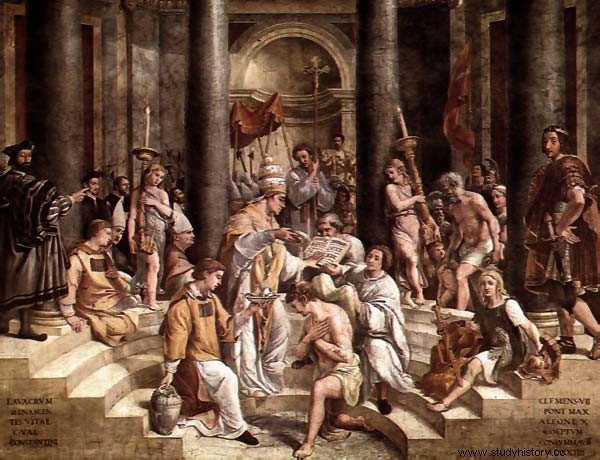If Saint Peter was the stone on which the Church was built, Constantine I the Great he could be considered the architect and, above all, the one who financed the construction of the Church. After the celebration of the Council of Nicaea (today Iznik, Turkey) in 325, the foundations and structure of the new Church were laid; In addition, and as if it were the millionaire inheritance of a distant uncle who went to the Americas, he received the Constitutum domini Constantini imperatoris (Donation of Constantine)…
the Pope [at this time Sylvester I], as successor of Saint Peter, has primacy over the four Patriarchs of Antioch, Alexandria, Constantinople, and Jerusalem, also over all the Bishops in the world. The Lateran basilica in Rome, built by Constantine, will rule over all churches as head, likewise the churches of St. Peter and St. Paul will be endowed with rich possessions. The main Roman ecclesiastics who can also be received as senators, will obtain the same honors and distinctions as these […] The Pope will enjoy the same honorary rights as the emperor, among them, that of wearing an imperial crown, a purple cape and tunic, and in general all imperial insignia or signs of distinction […] The emperor presents the Pope and his successors with the Lateran Palace in Rome, as has been said, like all the provinces, places and cities of Rome and Italy or the regions Western […] The emperor has established for himself, in the East, a new capital that bears his name, and there he will transfer his government, because it is inappropriate for a secular emperor to have power where God has established the residence of the head of religion Christian [...] The document concludes with curses against all those who dare to violate these gifts and with the certainty that the emperor has signed them with his own hand and has placed them in the tomb of Saint Peter.

Baptism of Constantine
A detail of taking the capital of the Empire to Constantinople so as not to mix temporal and celestial power. This document, which certified the spiritual power over all of Christianity and the temporal power over certain territories, was used by the Popes throughout the Middle Ages in the multiple puddles in which the Church got into due to territorial conflicts. Until cake was discovered in the fifteenth century... it was more false than Judas . In addition, a year later, Constantine had to issue an edict limiting the access of the rich and noble to ecclesiastical positions, since they only sought social relevance and, above all, the exemption of certain taxes that the Donation of Constantine granted to the clerics.
In 337 Constantine died and his children shared the Empire: Constantine II he received Britain, Gaul and Hispania; Constant he reigned over Italy, Africa and the Illyrian provinces, remaining for Constantius Constantinople and all the East. Years later, Constantius returned to unify the Empire. Following the policy of his father, and trying to favor the Christian Church, he proclaimed new measures in which the clergy were granted free use of transport for official trips (councils, synods...) - made the law, made the trap -. That became a joke and the clergy made all trips official. Constantius decided to tackle the problem, but taking advantage of it. The decree was modified and now it had to be the Emperor himself who gave the “official” character to the trip and, therefore, if it was free. What he did was approve only the strictly official ones and, moreover, only those members of the clergy who were supporters of his policy. If we add to this that the clergy should not be willing to pay transportation costs, the fact is that with this subtle measure the Emperor, even without being present, influenced the decisions made in the councils or synods.
